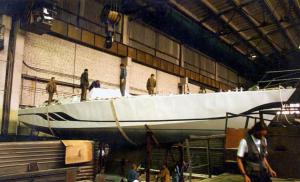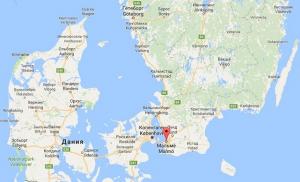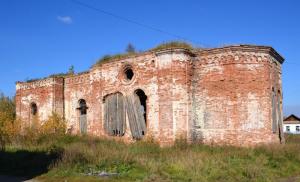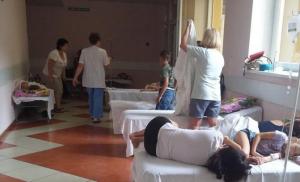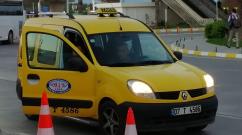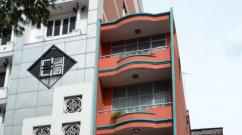Chianti wine route. In search of the "drunk road"
Siena (Siena) - Chiantigiana (Chiantigiana) - Firenze (Florence) - 70 km + 0 euro
The time has come to say goodbye to Siena. We never saw our Dionisio again. They left him a farewell note with thanks and the keys on the table. The door was slammed.
Then our path lay to Florence, but not along the highway, but along one of the most beautiful roads Chiantigiana. On the map it has №222
. The plan was to visit a couple of towns along the way and, of course, wineries fattorie and buy real Chianti Gallo Nero.
There is no point in talking about the beauty of this road. Some sources write that this is the most beautiful road, at least Italy and even Europe. I’m not ready to agree with this, there are more beautiful ones. But the fact that she has a unique charm is undeniable.
About 26 km from Siena, we stopped in a picturesque town Castellina in Chianti. Walked along the covered walkway Via delle Volte. It is small but charming, with many museums, designer shops and leather shops.
From the passage we went into the city center. 


In the city center there is a magnificent restored castle. Restored so much that its antiquity is not felt. 
Local wine and olive oil are sold on every corner, for example Bottega del Vino Gallo Nero (Via della Roca 10).
But we decided not to buy anything in the cities; we wanted to be as close to natural as possible, that is, we decided to stop by some farm. There were a lot of signs along the way "VenditaDiretta"(direct sales). We turned to one of these. We drove for quite a long time along a terribly dusty country road among fields and already doubted that we would meet at least some kind of civilization. And finally, we unexpectedly arrived at some small village and a rather pleasant building, where we understood that the farm sales department was located Santo Stefano. We were greeted by a friendly young girl and man. They told us about their wine and let us taste everything, including olive oil, for which they served us slices of delicious bread. 

Of course, we gladly bought Chianti, white wine and oil. By the way, the Russians haven’t visited them yet. They say that mainly the French, English and Germans come.
Then we went to Greve in Chianti. A wine festival is held here. Somehow the town was not impressive and we moved on to the castle Verrazzano (Castello di Verrazzanj), which is 4 km from Greve in Chianti. The castle also sells local wines and olive oil. The castle itself can only be accessed with a guided tour and at a certain time. We photographed him from behind bars, wandered around the area and admired the magnificent views of the Tuscan hills. 



Not getting there Strada in Chianti there is also a castle Castello di Mugnana, the best preserved medieval castle, around which there is also a lot of fattorie, but we did not go there, but turned into another farm Tenuta Poggio ai Mandorli.
An auntie met us, took us to the cellar, listed the wines and offered to try one to choose from, although we couldn’t try expensive wines (more than 10 euros). We were surprised by this situation, but since we didn’t intend to go anywhere else, we bought a couple of bottles from her. But among themselves they called her a greedy aunt. Apparently the proximity to Florence had an effect, and she was not at all surprised by Russian visitors, she says that they stop by often. That's where the dog is buried! She probably tasted it well.
From this farm we went straight to Florence. I must say that on this day, despite the short mileage, we were completely out of time and arrived in Florence in the evening, closer to 5 pm.
We immediately stopped by Piazzale Michelangelo, which offers a beautiful view of the city with the bulk of the Duomo and the tower of the Palazzo Vecchio, the Arno River with a series of bridges, including Ponte Vecchio. 

There is a huge free parking lot on the square, with a lot of cars. And it was still very hot - 41 degrees! In the open square on the hill it is an unbearable heat. 

It was getting close to evening and it was time to check in. We booked a hotel "Hotel City" (Via Sant'Antonio, 18), which is located in very convenient place, near the railway station, the Medici Chapel, a few steps from the Duomo. Reviews about the hotel were excellent, which was confirmed in reality. A cozy homely room of two rooms, with air conditioning, windows overlooking a quiet courtyard, an excellent bathroom with everything you need, a good breakfast and wonderful staff cost us 185 euros per night + 3 euros per person tourist tax. Parking is paid, the hotel has its own parking spaces at the station, it costs 25 euros/day, you can leave and enter as many times as you like. This is normal for the center of Florence during peak season. And for us, exhausted from the Siena Palio, everything seemed like paradise.
But we had to get to the hotel. It was difficult. We always ended up on ZTL. They circled, circled, spat and drove into the zone, parked not far from the hotel. But it turned out everything was fine. They took us to some database and told us that since we live here, we won’t get fined. This is how it turned out later.
We quickly settled in and went for a walk. Since Katya and Victor had already been in Florence the previous day, we each ran off in our own directions.
First I went to Churches of Santa Maria Novella which was designed and built by Dominican monks. Work on the construction of the church was completed in the second half of the 14th century. The marble façade of the church, designed by Leon Battista Alberti, dates from 1456–1470.
The most interesting detail in the interior of the church are the pylons in the form of a bunch of columns on which pointed arched vaults rest. In the Church of Santa Maria Novella is kept large number works of Florentine art of the 14th–16th centuries by Vasari, Ghirlandaio, Brunelleschi, Giuliano da Sangallo, Ghiberti and other masters. 

From this church I went to the Duomo Cathedral - Cathedral of Santa Maria del Fiore.
I immediately bought a ticket to Baptistery of St. John the Baptist (Battistero di San Giovanni) for 5 euros to see the famous dome of the Byzantine mosaic of the 13th century and the equally famous doors, the panels of which were created by Andrea Pisano and Lorenzo Ghiberti based on biblical scenes. 

After that I went for a walk. How to describe your feelings that arose as a result of the walk? And I had a feeling of confusion. I wandered the streets and realized that I was confused and... depressed. For the first time, the city did not let me into its soul. It's as if the city has its own protective shell, and I'm outside it. I sat down on the steps of some building and wanted to cry, or even better, to go home. I walked a couple more steps and met Katya and Victor. We walked until dark, but the feeling that you were a stranger did not disappear. Katya gave a good definition of Florence: Florence is a block. 







The next day, for the 12th day, we bought tickets to the Uffizi Gallery. We bought it in advance through the website for 11 euros + 4 euros reservation. Therefore, in the morning I had to climb onto the dome of the Duomo, visit the Duomo itself, then get ready, load my things into the car and run to the gallery.
In the morning the streets were still deserted, but at the entrance to the dome there was already a long line that was moving quite quickly. The ticket cost 8 euros. 








In order to enter the cathedral itself, you need to go down from the dome, go outside and stand in line again. There is no need to be afraid of the queue, it moves quickly. Admission is free.
The dimensions of the Duomo are amazing: 153 meters long and 90 meters wide. Today, Santa Maria del Fiori is the fourth largest cathedral in the world, behind only St. Peter's Basilica in the Vatican, St. Paul's Cathedral in London and the Duomo in Milan.
The Cathedral has a museum containing two priceless paintings - Michelangelo's Lamentation of Christ and Donatello's Mary Magdalene.
Despite the huge number of people in the cathedral, I still had great pleasure and looked around it with interest. 




We quickly checked out of the hotel and went to the Uffizi Gallery on foot. Walking through Via De' Tornabuoni, we looked into the church, which is located at the intersection with the street Via degli Agli. We noticed this church in the evening, but it was closed. Why she attracted our attention, I don’t know; she didn’t differ in anything remarkable in appearance. Moreover, it is ignored by guidebooks and tourist maps at best, it is simply marked with a cross without a name. So we went into it without knowing the name. Now I already know what it is Church of Saints Michael and Gaetano (Chiesa dei Santi Michele e Gaetano). Church of the 16th century. We were amazed by the interior decoration using magnificent textiles, which turned out to be from the 18th century.
I highly recommend visiting it. Only here did I feel that Florence had opened its door to me a little. 

As we had been warned, there was a huge queue to get into the gallery. But for those who have paid tickets, there is a separate entrance, completely without a queue. We spent about 3 hours in the gallery. Among the treasures stored in the Uffizi Gallery are masterpieces by Giotto, Caravaggio, Titian, Leonardo da Vinci, Rubens, and Perugdio. Only in this Florentine museum can you see Michelangelo's famous work depicting the Holy Family, as well as works by Raphael, "The Adoration of the Magi" by Gentile da Fabiano, "The Birth of Venus" and "Spring" by Botticelli. The best works of the greatest masters of the Renaissance - that's what the Uffizi Gallery is today. We saw all this, trying with all our might not to fall into a stupor from culture shock.
The gallery windows also open beautiful views on the Arno River and Ponte Vecchio, there are places to relax. 

This is the end of my first acquaintance with Florence. I concluded for myself that Florence is one of the cities that needs to be seen from the inside, where there is interesting architecture, but the main treasures are inside museums, cathedrals, and galleries.
Chianti Classico is the region between Florence and Siena, which includes the villages of Greve, Panzano, Gaiole, Radda and Castellina.
Greve in Chianti
Greve in Chianti / Shutterstock.com
Our journey cannot fail to begin in Greve, the entrance gate of the Chianti region. This lively town is famous for its quaint triangular square, where local farmers have sold their wares since the Middle Ages. The square is framed by porticoes on all three sides; they provide shelter from the heat or rain while shopping. In the center stands a monument to Giovanni da Verazzano, the designer of New York Harbor. In a narrow part of the square is the medieval church of Santa Croce, which houses several masterpieces of ecclesiastical art, including the triptych "Our Lady and Saints" by Bicci di Lorenzo.
In Grezzo you can taste traditional Chianti products and wines. Under the porticoes you will find local artisan shops, wine bars and restaurants. Don't miss the Falorni butcher shop, which offers a range of local delicacies. A stone's throw from the square is the Wine Museum.
Panzzano in Chianti

Panzzano in Chianti / Shutterstock.com
The densely populated town of Panzano is located a few kilometers from Greve. Since the 12th century, Panzano has played an important role in the defense of Florence. Panzano Castle was a strategic point during the wars between Florence and Siena. Traces of the castle are clearly visible in historical center. Nowadays, the center is dominated by the building of the Church of Santa Maria, founded in the 13th century, but significantly rebuilt in the XIX century in neoclassical style. It is worth taking a stroll through the city center, which has preserved the atmosphere of the Middle Ages, and drinking a glass of wine at central square. Here you will also find many restaurants and wine bars where you can taste local products. Stop by the old butcher shop Cecchini, where they sell the famous Florentine steak.
A little further is the Church of San Leolino, the first mention of which dates back to 982. Despite its Renaissance appearance (an elegant stone portal and arched gallery), its interior has been preserved in its original form, typical of a Romanesque three-nave basilica. Inside you can admire the framed masterpieces of church art by local masters.
Castellina in Chianti

Castellina in Chianti / Shutterstock.com
Moving further towards Siena, you will find yourself in Castellina in Chianti, a town so ancient that its origins are lost in the darkness of centuries. In any case, the tombs in Montecalvario indicate that people lived here already in Etruscan times. Geographical location at the intersection of four districts of the Chianti region, they made the town an important military point, a strategic point between Siena and Florence. Since the period of medieval wars, the Rocca fortress has been preserved here, dominating the central part of the city, and a covered passage (via delle Volta), crossing the city right through. Its windows offer breathtaking views. Walking around the city, you will see many magnificent palazzos that belonged to noble Sienese and Florentines. Don't miss the Church of San Salvatore, rebuilt after the Second World War, which contains a magnificent late 14th-century fresco by an unknown Tuscan artist. It is definitely worth visiting the Archaeological Museum of Chianti Senese, where Etruscan finds from excavations in Montecalvario are kept, to become familiar with ancient history of this land.
As at other points on the route, here you can taste local wines in one of the many wine shops and try the famous sausages and hams made from local pork.
Radda in Chianti

Radda in Chianti / Shutterstock.com
Leaving Castellina along Via Chiantigina, you find yourself on the SR429 highway, which leads to Radda in Chianti, a town that has retained its medieval charm. The city center - a labyrinth of concentric streets - is still surrounded by an ancient wall. The architectural center of the city is considered to be the Palazzo di Podesta and the Romanesque church of San Niccolo. The captain of the Chianti League met in the palazzo for four centuries, as is recalled by the numerous coats of arms on its façade. On the edge of the city you will find the ancient Franciscan monastery of Santa Maria in Prato.
Here it is pleasant to wander through the alleys of the center, where magnificent views of the valley surrounding the city open up every now and then. A glass of wine with panino will help you restore your strength.
Near Radda there is the ancient fortified town of Castello di Volpaia. The fortress is built of dark sandstone, which makes it different from other fortifications in the Chianti region. Although the wars between Florence and Siena did not pass without a trace for him, the massive main tower and one of the small towers have survived to this day. Don't forget to visit the former 14th-century church of Commenda di San Efrosino, which now houses a wine library. This is where you should taste the famous local wines.
Gaiole in Chianti

Gaiole in Chianti / Shutterstock.com
Not far from Radda is the town of Gaiole in Chianti, founded during the Middle Ages. Thanks to its position halfway between Chianti and Valdarno, it became a trading platform where local feudal lords sold their products. In our time, Gaiole has not lost its significance, being an important tourist center. There are many hotels and restaurants of the “agritourism” category, wine shops and farms, the owners of which will be happy to offer you their products and hospitality. In the vicinity of Gaiole, castles and fortresses have been preserved, for example Castello di Vertine, Castello di Meleto, Pieve di Spaltenna. You can stay overnight everywhere and, of course, taste local products.
Traveling through the Chianti Valley and Siena in September is a great trip to the historical region of Tuscany.
Prices and options for Tuscan travel
- VISA TO ITALY - with delivery
- WHEN -
- TRAVEL INSURANCE ITALY –
- HOW TO GET THERE - the capital of the historical Italian province of Tuscany is Florence, where the airport is located, the area is connected by bus routes and railway lines. There is also an international airport in Pisa, from which you can always reach Florence in an hour.
- AIR TICKETS TO TUSCANY –
- TRANSFER —
- TRAIN TO TUSCANY - yes
- BUS TICKETS –
- TRANSPORTATION - while exploring the original towns of Siena and Chianti, you can walk or use public transport To explore all the sights of the region, it is still more convenient to rent a car.
- CAR FOR RENT –
- TRAVEL FRIENDS - to Siena and Chianti
- WEATHER - The climate of Tuscany is quite mild, it is warm here in September, and the average air temperature during the day rarely drops below +24 ... 25 ° C.
- WHERE WE WILL BE - Florence, Radda in Chianti, Badia a Coltibuono, Greve in Chianti, Siena, Collegiate, San Gimignano, Montalcino, Montepulciano, San Agostino.
- EXCURSIONS - to Greve, Gaioli, Florence, Siena, Radda.
- ACCOMMODATION AND FOOD - While vacationing in Siena and Chianti, you can choose a cozy tiny hotel in the cities of Siena, San Gimignano, or Greve in Chianti, accommodation is possible in picturesque rural guest houses-estates. There are many Italian restaurants open in Chianti, where you can get acquainted with national Tuscan cuisine.
- GUIDE GUIDES - .
- HOTELS - , or .
The luxury of Tuscany - the provinces of Chianti and Siena
You can explore the original corners of the Chianti region, explore the surroundings of Radda (formerly former capital League of Chianti Towns), there is a medieval abbey nearby called Badia a Coltibuono, and in the evening it is better to go to Siena and have dinner at a restaurant in Piazza del Campo.
Day 4-5 – Siena
Stroll through ancient Siena, visiting the Palazzo Publico, the Duomo, the Metropolitan Museum of Art and the Civico Museum. On the fifth day, visit Siena's Pinacoteca, explore the interiors of the Church of Santa Catarina, and then head to the ruins of the medieval Abbey of San Galliano.
Day 6-7 - Collegiate, San Gimignano, Montalcino, Montepulciano, San Agostino
 On way back in Florence, visit the charming towns of San Gimignano, Collegiate, Montalcino, San Agostino, Montepulciano, Tuscan villages, and admire the vineyards. , then you can spend the night halfway and continue your trip to Tuscany in the morning.
On way back in Florence, visit the charming towns of San Gimignano, Collegiate, Montalcino, San Agostino, Montepulciano, Tuscan villages, and admire the vineyards. , then you can spend the night halfway and continue your trip to Tuscany in the morning.
Upon returning to Florence, our trip through the Chianti Valley and Siena was completed. We didn’t see much in Tuscany, so maybe we’ll come back again. New travels to you!
Chianti is exactly what you think it is. The wine fully reflects the characteristics of the region. Through it you can assess how sunny days in Chianti, how rich the aromas of its herbs are, how clean the air is and how measured life is. The landscapes of Chianti are endless vineyards, interrupted only by the houses of their owners, well-groomed greenery, hills lined with bushes one after another. For lovers of such idyllic pictures, they even built a special road that will lead through the best wine-growing lands directly to the homeland of the famous Chianti - Brolio Castle.
There are ancient towns scattered throughout the region, where the atmosphere of rural life in the sunshine has been preserved. Leonardo da Vinci appreciated the beauty of these places; it is hardly by chance that he painted the famous Mona Lisa here. According to one version, the Mona Lisa was from Chianti.
Flights to Chianti
Departure city
Enter your departure city
Arrival city
Enter your city of arrival
There
!
Back
!
Adults
1
Children
Up to 2 years
0
Up to 12 years
0
Find a ticket
Calendar of low prices for air tickets
How to get to Chianti
By plane
The airport, which serves the Chianti region, is 1 km from the center of Pisa and 80 km from Florence. There are no direct flights from Moscow, so you will either have to be content with connecting flights through Rome or other European cities, or use ground transport.
By train
Net railways connects the cities of the Chianti region with each other and with neighboring provinces. Florence and Siena can be reached from Rome and Milan in a couple of hours.
Hotels in Chianti
City
Enter city name
Arrival date
!
Departure date
!
Adults
1
Children
0
up to 17 years oldFind a hotel
The Chianti region is dotted with hotels and guesthouses; the choice depends solely on the preferences of tourists and their transport capabilities. It’s convenient to move between towns by car, and then you don’t need to get attached to large settlements. In this case, you can choose a picturesque house away from the noise, feel like the owner of a grape plantation, wake up and watch orderly rows of plantings from the window. Many hotels are occupied by old mansions, where you can also pretend to be at least a duke. At the same time, it is not necessary to empty your treasury completely.
The minimum cost of accommodation in Chianti is from 40 € per night for two. For this money you can get a simple room in a house or hostel, for example, in Greve (Residence Casprini da Omero) or Gaiole (La Fonte Del Cieco, Villa Vittoria Gaiole In Chianti). In Gaiola, you can also stay like a king at the five-star Castello di Spaltenna Exclusive Resort & Spa (from 200 €), and there are several similar places in Castelnuovo Berardenga.
The cost of three-four rooms varies from 80 to 300 € per night.
Shopping in Chianti
Wine. Wine. And again wine. You can take it out even in boxes, the main thing is to check it in as luggage, meeting the standards of your airline. However, difficulties may arise when entering Russia. According to current customs regulations, you can import no more than 2 liters of strong alcoholic beverages per person into our country. In addition to wine, Chianti produces grappa, limoncello, and cognac. The marking - a red label with a black rooster in the center - speaks of high quality. Good wine costs from 10 €.
In addition to alcohol, you can bring local olive oil, cheeses, sausages and boar meat delicacies from Chianti.
Wine tasting in Chianti
Any establishment will offer visitors local wine. But some places enjoy special love among Italians and the interest of foreign tourists.
In Panzano, queues form for Antica Cecchini. This legendary butcher shop is famous for its Florentine steak, where the owner reads passages from Dante's Divine Comedy and pours homemade wine from his private cellars. In the shop of butcher Dario Cecchini there are autographs of fans of his creative approach to carcass and work: Dustin Hoffman, Jack Nicholson, Elton John and other celebrities.
Castellina has two Michelin-starred restaurants whose chefs prepare dishes that best pair with Chianti from different vintages.
In Radda, you can visit the Volpaia Castle, where they offer tasting tours with a sample of freshly squeezed olive oil. Of course, they won’t let you go without a glass of wine either. The drinking place will be an ancient church turned into a bar, or a picturesque garden.
At Meleto Castle in Gaiole, after a tour of the castle and winery, you can taste wine, grappa, and cognac with an appetizer of locally produced cold cuts. There is also honey and organic olive oil. Everything can be bought right there.
If you were asked to drive along the Chianti wine road in search of " drunken road", would you agree? So I had no reason to deny myself such an adventure. So what is hidden behind such beautiful description and what is this road famous for?
2. “The Drunken Road” is the calling card of Tuscany, the Orcia Valley and the city of Monticchiello to which it leads. An asphalt ribbon lined with cypress trees, descending from the most picturesque hills, is included in the UNESCO heritage. Her images decorate magnets, spoons, postcards, and stamps. Locals They even sometimes pray for her. I'll post a postcard as a guide. This is what we went for.

3. Traveling through Tuscany was difficult. Leaving Florence, we turned onto the Chianti wine road and headed for miracles. It would seem that what is so difficult here? Go, you just have to go.

4. But the trouble is that the landscapes of Tuscany are incredibly beautiful. And instead of the road, you want to look around, the speed drops to a minimum, cars honk behind you, you trudge along like a stoned drug addict. In 30 minutes we drove only 20 kilometers, took a hundred photographs and began to understand that we might not make it on time. But I simply didn’t want to go any further. Could stop at every bush, stone, vineyard

5. The closer we got to the Val d'Orcia valley, the more difficult it was to press the gas. I couldn't stand it, turned on the emergency lights, pressed to the side of the road and took photos, photos, photos.

6. People who are in love with landscapes and romantic natures simply should not be allowed into Tuscany. There is a chance that their psyche will be disturbed, and they will not want to return to their home country.

7. At a certain moment the thought came to me, did I even give in to the “drunk road”? You might as well stay here. Enjoy the views, uncork a bottle of dry white and experience zen.

8. There are no problems with bottles. There are local shops along the road where you can buy quality, homemade, Tuscan wine. How difficult it is to move on!

9. If you know about wine, then cities like Montalcino and Montepulciano will gently echo in your ears, your hands will reach for the glass, and your lips will whisper I want.

Sponsor's Corner
CALL THE PASSWORD "LJ" AND RECEIVE A 5% DISCOUNT ON ANY TOURS!
The Mercury company was founded in 2004 and is one of the leading tour operators in Italy, as well as other countries of the world. The company organizes both individual and group tours. Travel and vacation are learning something new, unknown, new acquaintances and hobbies. The journey should correspond to your inner world and ideas! To be the way you see it, so you can always be confident in the individual approach of the company’s managers, who know and love Italy, and attentive attitude to any of your wishes. Tours to Italy or any other country in the world at your request.
10. Oh, it’s not for nothing that this path is called the wine road, because 80% of the territory of Tuscany is covered with vineyards, and local wineries have received world fame and gold medals from various competitions of the noble drink.

11. Did I already say that it is very difficult to drive and not stop?

12. During the Renaissance, students of the Siena art school honed their skills in local natural landscapes. The paintings still reflect the beauty of Tuscany. How is it even possible not to become an artist, poet or winemaker here?

13. I couldn’t stand it. He abandoned the car and ran into the fields.
14. If there is beautiful scenery, delicious wine, then you can live here. We must give the Italians their due, not to spoil the beauty of these places, but even to embellish them - art. I'll tell you about a couple of local towns soon. They deserve a separate story.

15. Almost there. There's just a little bit left. Here she is already drunk dear, only the view from above. Was it in vain?

16. But first, a couple more landscapes.

17. Almost finished postcard or magnet. I'm thinking of ordering it for friends and giving it as a gift. It's a good idea to give magnets of your own production with your photographs. Or I’ll put together a collection and donate it to New Year calendar for everyone.

18. It was not in vain that I traveled. Oh, not in vain. I denied myself wine, swallowed saliva, and hurried at stops. Not in vain.


